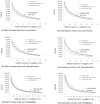Costs and cost-effectiveness of a collaborative data-to-care intervention for HIV treatment and care in the United States
- PMID: 36682053
- PMCID: PMC9867888
- DOI: 10.1002/jia2.26040
Costs and cost-effectiveness of a collaborative data-to-care intervention for HIV treatment and care in the United States
Abstract
Introduction: Data-to-care programmes utilize surveillance data to identify persons who are out of HIV care, re-engage them in care and improve HIV care outcomes. We assess the costs and cost-effectiveness of re-engagement in an HIV care intervention in the United States.
Methods: The Cooperative Re-engagement Control Trial (CoRECT) employed a data-to-care collaborative model between health departments and HIV care providers, August 2016-July 2018. The health departments in Connecticut (CT), Massachusetts (MA) and Philadelphia (PHL) collaborated with HIV clinics to identify newly out-of-care patients and randomize them to receive usual linkage and engagement in care services (standard-of-care control arm) or health department-initiated active re-engagement services (intervention arm). We used a microcosting approach to identify the activities and resources involved in the CoRECT intervention, separate from the standard-of-care, and quantified the costs. The cost data were collected at the start-up and recurrent phases of the trial to incorporate potential variation in the intervention costs. The costs were estimated from the healthcare provider perspective.
Results: The CoRECT trial in CT, MA and PHL randomly assigned on average 327, 316 and 305 participants per year either to the intervention arm (n = 166, 159 and 155) or the standard-of-care arm (n = 161, 157 and 150), respectively. Of those randomized, the number of participants re-engaged in care within 90 days in the intervention and standard-of-care arms was 85 and 70 in CT, 84 and 70 in MA, and 98 and 67 in PHL. The additional number of participants re-engaged in care in the intervention arm compared with those in the standard-of-care arm was 15 (CT), 14 (MA) and 31 (PHL). We estimated the annual total cost of the CoRECT intervention at $490,040 in CT, $473,297 in MA and $439,237 in PHL. The average cost per participant enrolled was $2952, $2977 and $2834 and the average cost per participant re-engaged in care was $5765, $5634 and $4482. We estimated an incremental cost per participant re-engaged in care at $32,669 (CT), $33,807 (MA) and $14,169 (PHL).
Conclusions: The costs of the CoRECT intervention that identified newly out-of-care patients and re-engaged them in HIV care are comparable with other similar interventions, suggesting a potential for its cost-effectiveness in the US context.
Keywords: HIV surveillance; cost-effectiveness; data-to-care; economic evaluation; randomized controlled trial; re-engagement.
© 2022 The Authors. Journal of the International AIDS Society published by John Wiley & Sons Ltd on behalf of the International AIDS Society.
Conflict of interest statement
The authors declare no competing interests.
Figures
References
-
- Panel on Antiretroviral Guidelines for Adults and Adolescents . Guidelines for the use of antiretroviral agents in adults and adolescents with HIV. Department of Health and Human Services. https://clinicalinfo.hiv.gov/sites/default/files/inline‐files/AdultandAd.... Accessed April 27, 2021.
-
- Centers for Disease Control and Prevention . Monitoring selected national HIV prevention and care objectives by using HIV surveillance data—United States and 6 dependent areas, 2018. HIV Surveillance Supplemental Report. 2020.
-
- Centers for Disease Control and Prevention . Effectiveness of prevention strategies to reduce the risk of acquiring or transmitting HIV. Atlanta, GA: Division of HIV/AIDS Prevention, National Center for HIV/AIDS, Viral Hepatitis, STD, and TB Prevention; 2019.
-
- Fauci AS, Redfield RR, Sigounas G, Weahkee MD, Giroir BP Ending the HIV epidemic: a plan for the United States. JAMA. 2019;. 321(9):844–5. - PubMed
-
- Centers for Disease Control and Prevention . Ending the HIV epidemic: a plan for America. https://www.cdc.gov/endHIV/. Accessed November 13, 2019.
Publication types
MeSH terms
Grants and funding
LinkOut - more resources
Full Text Sources
Medical


